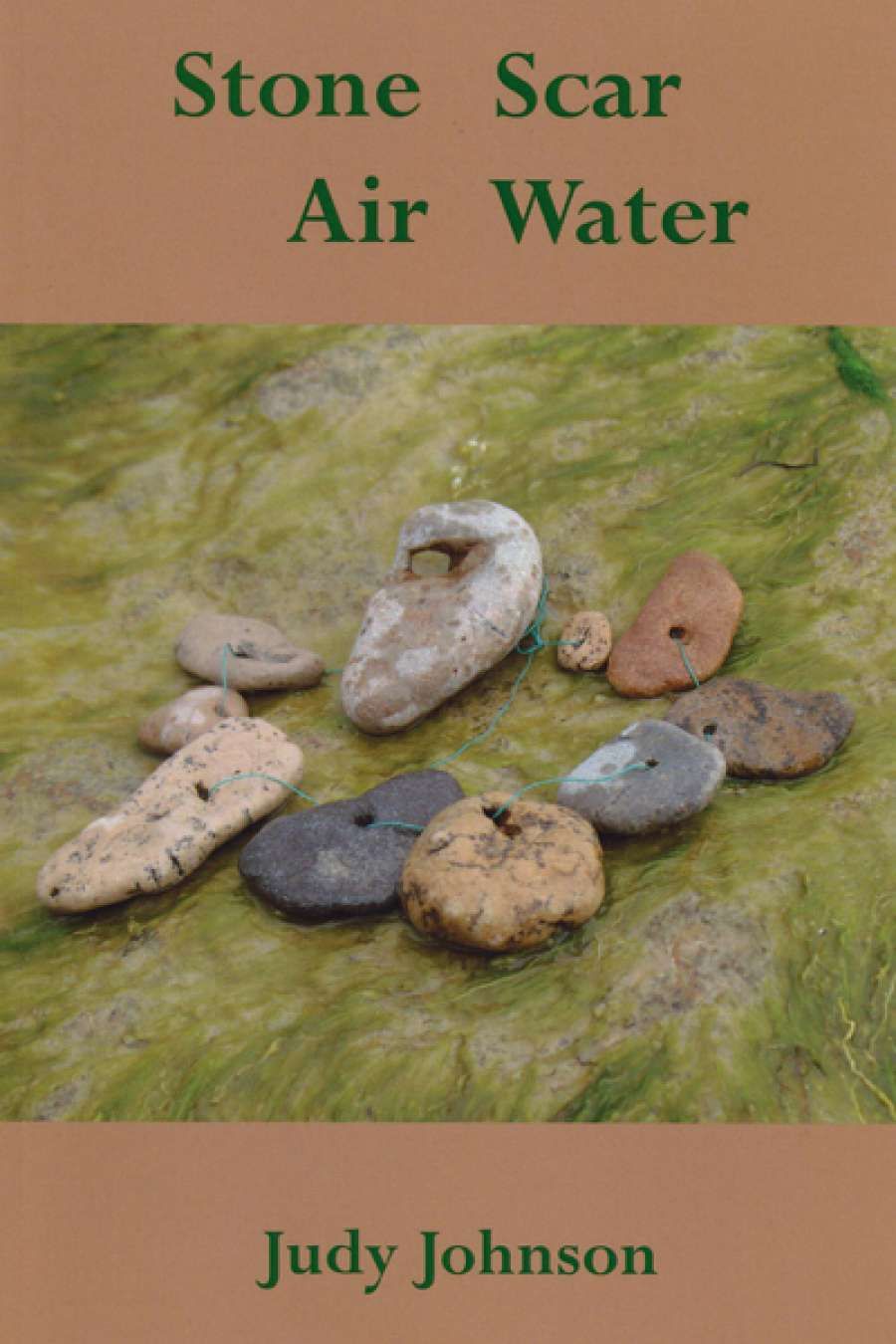
- Free Article: No
- Contents Category: Poetry
- Custom Article Title: Rose Lucas reviews 'Stone Scar Air Water' by Judy Johnson
- Custom Highlight Text:
Judy Johnson’s sixth collection of poetry brings us a strong range of closely observed, powerful poems. As the title suggests, they are all linked together by elemental themes: the apparent solidity of stone, the persistence of scar tissue, the promises of air, and the complex gifts of water. In their often very ...
- Book 1 Title: Stone Scar Air Water
- Book 1 Biblio: Walleah Press, $20 pb, 131 pp, 9781877010323
In a short lyric poem such as ‘The Kites of Ma Chia-shu,’ the lines are themselves filled with the expansion of white space, similar to the way air buoys the children’s kites as they ‘ascend in a staggered climb / then dip and dive / stirring the pale shot-silk of the day’. The exercise of making a kite in order to allow it to ‘float away altogether’ reflects much about Johnson’s attitude to making poetry. The intricate image and the close watching of the world work toward moments of release, when the poem, like the kites, ‘each bobbing inside / its frame of attachment’, is snipped free of the poet’s loving craft to find its own way into an expanse of sky.
Johnson is also interested in exploring longer poetic sequences. ‘Wolf in Sheep’s Clothing’, for example, is multilayered in its references and images. Inspired by a painting by the Dali-esque visual artist Lisa Adams, Johnson revisits Tom Roberts’s iconic Australian painting, Shearing the rams (1890), and finds new ironies of history and violence. These in turn take her attention back to colonial origins, the arrival of her own African-American ancestors and the struggle of viewpoints which this engendered: ‘How the tribe that waited on shore was at first / more curious than suspicious / watching the men disembark like a mob of sheep / down a ramp. Of course they did not / know a sheep, let alone those eleven / African American wolves in the midst of the flock.’
The sequence ‘Michelangelo’s Daughter’ unravels the potentially abusive relationship between father and daughter, artist and canvas, and the struggle for the power to speak, let alone create. It is an uncomfortable series of poems, which, like ‘Wolf in Sheep’s Clothing’, reacts to external points of reference in order to shape its own story of emotional damage and resilience. This technique is also explored in two other poems that use the structure of narrative and history as the canvas for poetic exploration, in particular of female experience. ‘The Navigations of Rose de Freycinet’ follows aspects of the story of the wife of the explorer, disguised as a man aboard his ship, who becomes disoriented by the profound changes in perspective she both witnesses and experiences. On her return to Europe after ‘all this striving / for adventure and intensity,’ she is unsettled and finds herself ‘on the outside looking in’. Any Enlightenment goals of linearity and categorisation have been scrambled by antipodean perspectives and by the inversions of self that have resulted. Similarly, the sequence ‘The Last Days of Mary Watson’ explores the interior voice of a woman who, with her baby and Chinese servant, comes to an increasing knowledge of her impending death. The isolation of her position, as she drifts between tropical island and sand bar, her fear of the Aborigines, and her failure to understand them is rendered with feverish poignancy by Johnson’s evocation of mood and image. With the body of her child ‘feather heavy on my arm’, Mary finally wonders, ‘How else could a lizard / have gotten into the coop of the sky / and even now be looking back / the egg of the sun in its mouth.’
In the sequence ‘Irish Stone’, Johnson moves across various counties, touching and viewing and interpreting the meanings of different kinds of stone – its capacity for endurance as well as erosion, its links with the natural world as well as the human world of building and ambition. The scoured beauty of these poems, and their implied weaving of self and world, is distilled into the title poem ‘Stone, Scar, Air, Water’: ‘Husked between seasons in this cinnamon air / I watch the sails of skiffs / on the birdbath lake / dip beaks to tinseled water and realize / my heart’s adrift.’ It is the poet’s self-appointed task to delineate the entwinements of the world, ‘to tell you how it all once stood apart’. It is also the poet’s pain that this recognition is always fleeting, and the telling, which has ‘only words to recapture / detachment’, on a knife-edge of incipience and failure.
The poet’s struggle to find a resting point of attention and articulation is given shape in the collection’s final poem ‘Loom’. Expansive and suggestive in its open poetic form, it embodies an aesthetic of moving toward and away, a weft and a looping that is epitomised in the possibilities and losses of the ideas of ‘Autumn’ that punctuate the poem. Fluctuations of ‘diminishing returns [and] the concomitant / preciousness of things’ create the web which sustains both life and the poem, the breathing in and out of possibilities, the ‘Cleave to / Cleave apart’ that marks human experience. Johnson has produced an evocative and memorable collection, showing a poet clearly in charge of her craftbut also brave enough to go beyond the frames of the comfortable, naming and tracking the gossamer threads of the world through which she moves.


Comments powered by CComment